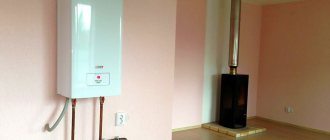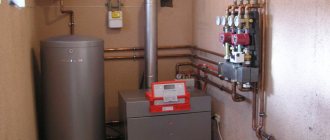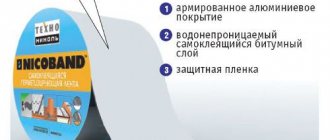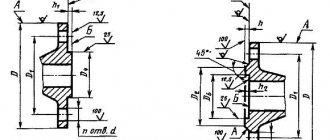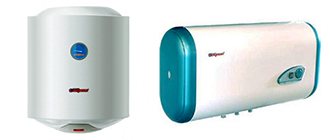What is a gas water heater
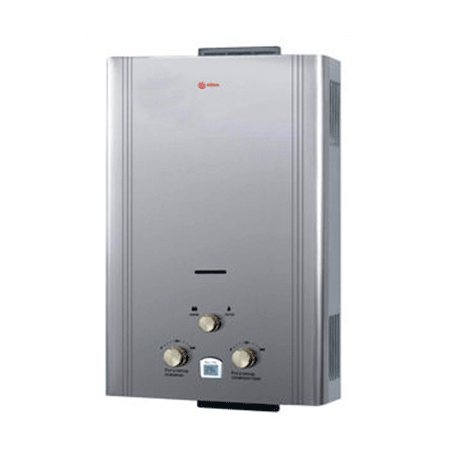
Gas water heater
A gas column is called a device that heats water due to the combustion of gas. The fuel is natural or liquefied gas.
Instantaneous water heaters are used in homes where there is no hot water supply. Due to the cost of the fuel consumed, these devices are much cheaper than the structures powered by electricity.
Advantages and disadvantages
In houses with low-power wiring, water can only be heated with a column, since a kitchen boiler cannot be installed in them. Such units are used in Khrushchev and Stalin buildings. There are models that can be lit with matches, temperature controlled or electronically controlled.
The advantages of the device are as follows:
- quickly heats up a large volume of water;
- the dimensions of the device are small, so it will not take up much space;
- hot water can be obtained immediately after turning on the column;
- relative economy of use, but it all depends on the cost of fuel.
A large number of installation requirements are due to the risk of disaster if misused.
Among the disadvantages are:
- the risk of fire or explosion, although most modern units are equipped with protection systems;
- the need for good ventilation, as can be poisoned by carbon monoxide;
- inability to install in the bathroom;
- the need to coordinate the installation with the water supply and gas service.
Modern technologies make it possible to obtain the most efficient devices, while maintaining the reliability of the unit and all components involved in the system.
Electric instantaneous water heater
Instantaneous water heaters work according to the following principle: passing through the heating element, water immediately flows from the hot tap (up to 60 ° C). Such devices are compact, easy to install and reinstall, if necessary, to a new place. Their big disadvantage is high power - from 3 to 24 kW. For this reason, they can only be used in places where the electrical network is designed for such a high power. In houses with conventional wiring, where there are gas stoves, the maximum permissible load on the electrical network is 3 kW.
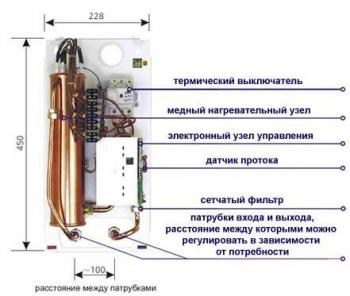

Therefore, choosing such a device, you will have to change not only the wiring, but also the meter, the introductory machine, and install an additional machine directly for the water heater. All these costs can exceed the cost of the water heater itself. In houses equipped with electric stoves, the maximum load on the network is 8 kW. In this case, an instantaneous water heater can be connected to the wiring for the stove, but these devices can only be used one by one. The main advantage of instantaneous water heaters is that they are able to supply hot water in unlimited quantities, but the disadvantage is the impossibility of simultaneously providing several points with hot water.
Technical requirements and operation
There are clear regulations regarding the installation of water heaters. Violation of the rules will lead to the fact that the gas will be turned off. You can count on its inclusion only after correcting all the shortcomings. Then a check is carried out and a permit for installation is issued. Manipulations should be carried out by organizations that have the appropriate certificates. Gas can be connected only with permission, so it is important to issue them on time.
The requirements for installing a gas water heater in an apartment are as follows:
- The size of the kitchen must be at least 8 square meters. m.
- It is important that non-combustible materials are used for the walls and masking panels.
- The ceiling is over two meters high.
- The diameter of the ventilation opening is at least 120 mm.
- Pipes up to 2.5 m long and 13 mm in diameter.
- Gas pipes must hang freely or be masked with an opening box. They cannot be walled up, since free access is needed.
- The gas shut-off valve should be located next to the heater and have a yellow handle.
- Chimney pipe made of steel or galvanized, its thickness is not less than 1mm.
- There should be a door in the room.
The device is operated according to the following rules:
- Gas devices are put on the balance sheet and checked once a year.
- There are models that are not serviced by gas workers. In this case, you need to contact the service center and call a specialist.
- When buying devices with a closed combustion chamber, the chimney does not need to be installed, but more attention should be paid to ventilation.
If the kitchen is combined with living rooms, then it is illegal to use gas appliances in this case.
Installation
It is necessary to start the installation by checking the premises for compliance with standards.
The rules are easy to follow in any utility room or kitchen in the apartment.
Requirements:
- at least 0.2 m3 of air volume per 1 kilowatt of apparatus power;
- the door is not more than 800 mm;
- there must be a ventilation outlet;
- when installing a water heater in a basement, a gas analyzer with a safety valve is required.
The water heater is hung on a metal bar, with more than 1000 mm to the floor from the lower edge of the apparatus, and 250 mm to the ceiling (wood) and 50 mm for non-combustible materials. The plank must be fixed strictly horizontally using a building level.
Fasteners depend on the type of wall, a dowel-nail of at least 60 mm is recommended. If the dowel is loose, replace it with another one, the water heater weighs a lot with water.
It is easy to do this process with your own hands, the main thing is to create a reliable support.
The column is connected to the chimney with a steel pipe or aluminum corrugated sleeve. Observing the same diameter of the outlet pipe and the connecting pipe.
The installation process is as follows: we put the pipe on the branch pipe and fix it with a metal clamp. Next, we insert the other edge of the pipe into the chimney, seal the cracks with a sand-cement mixture.
Requirements for the connecting section of the chimney:
- the length of the horizontal section is no more than 6 m;
- knees - a maximum of three pieces;
- the length from the branch pipe to the first elbow is not more than 50 cm.
Perhaps you will be interested in an article about Ariston storage water heaters. Read the article on repairing Ariston water heaters with your own hands here.
Installation algorithm and what is required for this
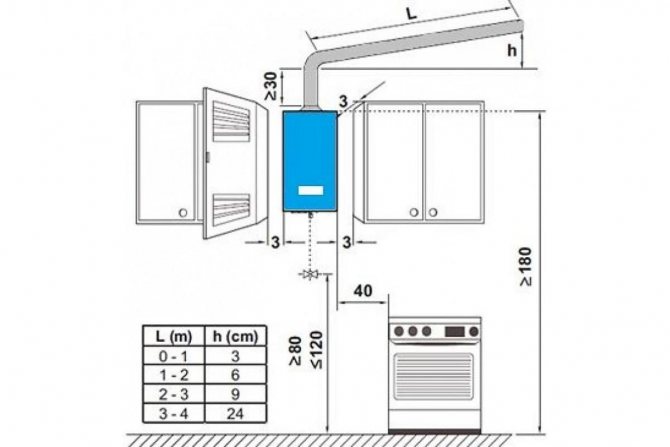

Construction installation diagram
It is possible to install a gas water heater only after collecting documentation and obtaining all permits.
If the model changes, you should:
- Purchase a device from a manufacturer who can confirm its quality with certificates.
- Take in the housing office the schemes of the gas and water supply system, which will indicate the place of the future location of the device.
- Go to the gas service with a statement to replace the unit, but the installation location must remain the same. It is also necessary to provide an application for the repair of water and gas pipelines.
- The gas service will carry out all the work and issue documentation confirming that the equipment meets the requirements and has been put into operation.
If they replace not only the device itself, but also rearrange it to another place:
- Change the scheme of gas, water and air outlet.
- They take an act from the fire inspection, which will confirm that the chimney is in good condition.
- The transfer project is ordered from GORGAZ or certified organizations. For apartment buildings, a redevelopment permit will be required, which is obtained from the city administration.
- With all the documents, they once again apply to the gas service, whose specialists will install and connect the device, and launch it for the first time.
After that I will seal the meter and issue the commissioning documents.
At the first installation, if gas has not yet been supplied to the house, you will have to build a gas supply line. This is an expensive procedure, therefore solid fuel boilers are more often chosen for a private house.
If there are many apartments in the building, then the developer, housing office or owners supply gas. After collecting all permits and documents, construction and installation work is performed and put into operation. Then they conclude an agreement on gas supply.
Installing new equipment instead of old
Experts advise purchasing a new water heater of the same type that was previously in your apartment or house. First of all, we are talking about the type of energy carrier. It is better to replace old electrical systems with similar water heaters, and install a boiler instead of a gas water heater. This will allow at least partially to avoid long coordination with the relevant authorities.
Remember that the connection diagram of storage water heaters differs from that required for the installation of a gas boiler. Therefore, when installing, it is wiser to use the manual written by the hardware manufacturer. As a rule, detailed recommendations are in the technical documentation that is attached to the water heater.
Installation of a gas water heater consists of 3 stages:
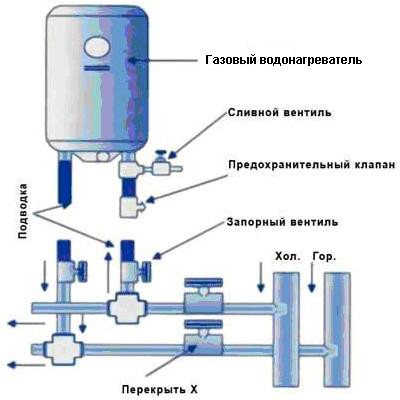

Diagram of connecting the boiler to the water supply.
- connecting the boiler to the gas pipeline;
- connection to the water supply main;
- installation of the hood.
First you need to dismantle the old gas water heater. To do this, you need to shut off the gas and water pipelines using shut-off valves. Using an adjustable wrench, unscrew the gas hose nut. If a metal pipe is installed instead of a hose, then dismantle the connection very carefully so as not to damage the gas supply pipe. First, the liner is disconnected from the gas pipeline, then from the old column. The hose must be carefully inspected.
If its condition is satisfactory, then it can be used to connect a new boiler. But it's wiser to establish a completely new connection. Remember that rubber hoses must not be used to connect the water heater to the gas supply system. It is better to purchase a flexible corrugated eyeliner made of stainless steel.
Last of all, the chimney pipe is disconnected, the old boiler is removed from the mountings. They also need to be checked. If the brackets are securely fastened to the wall, then the new water heater can be installed on them. Otherwise, new fasteners will need to be made.
Installation of new equipment
Chimney device diagram in the building.
Please note that the connection diagram for the gas boiler is the same as for the gas water heater. Actually, there are no big differences between these units, of course, if we are not talking about large water heaters, which are usually installed in private houses or specially equipped boiler rooms. The volume of a gas water heater can be from 20 to 500 liters. With the help of such a device, you can immediately get a large volume of hot water and supply it to several points (taps). Thus, you will provide all your home with hot water, regardless of its size.
The volume of treated water does not directly depend on the volume of equipment, as in storage water heaters. Remember that gas boilers are capable of operating at any pressure of water and gas.They are the ideal solution for people with low mains pressure in their homes. In any case, they will heat water almost 2 times faster than electrical systems.
A coarse filter and a tap must be installed in front of the heater to prevent dirt and rust particles from entering the burner. A pressure regulator is installed only on equipment that runs on liquefied gas.
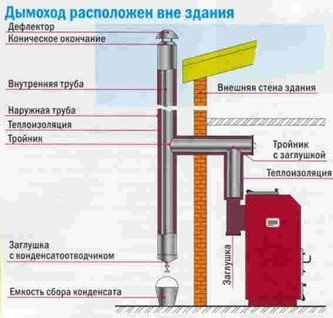

Diagram of the chimney device outside the building.
When installing a new water heater, you need to remember the requirements that safety rules impose. The height of the ceilings in the room where the boiler is installed must be at least 2 m, and the vertical of the chimney must exceed 50 cm.
Before starting installation work, the boiler must be installed in its designated place. The water heater is connected to the water supply system using PVC hoses and pipes. After connecting, check all components and make sure there are no leaks. The nuts of the flexible connections must be tightened tightly, but carefully so as not to rip the threads.
Next, the water heater is connected to the gas supply system, lubricating the joints with gas lubricant. After all connections are crimped, grease them thickly with soapy water. If soap bubbles did not appear during gas supply, then the connection is made correctly and securely.
List of required documents
To install a gas instantaneous water heater, it is important to collect a number of documents:
- Evidence will be required to prove that the person is the owner of the home and pays taxes.
- You need to allow the processing of personal information.
- Present a gas passport and a letter confirming that the contract for work has been concluded.
- Indicate which devices in the house are operated with gas.
- Show passport to gas meter.
You also need to make a copy of the page of the gasification project with the appropriate stamps.
Types of columns and boilers for apartments and a private house
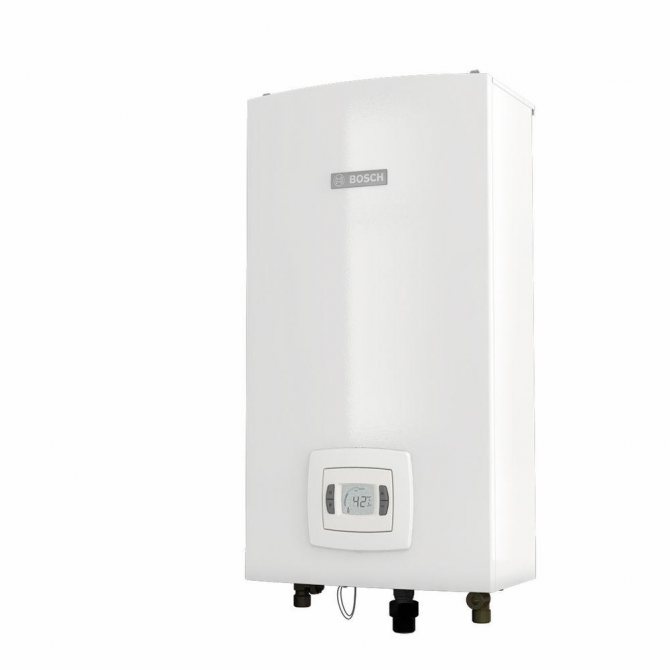

Flow device
Gas heaters are flow-through and storage. But gas boilers are rarely given preference, since they are not so convenient, are expensive and take up a lot of space in the room. They are recommended to be installed with too weak gas supply.
Therefore, most often, flow-through gas heaters are installed in apartments. Modern models are equipped with an open or closed combustion chamber. The first option is more secure, therefore it requires fewer documents during installation.
Such units are used in houses in which there is no chimney. If you need to replace the old device with a new one, all checks have already been carried out and the condition of the gas supply and chimney meets the standards, it is recommended to buy devices with a closed combustion chamber.
Manufacturers offer devices with different types of power:
- 17-20 kW. They are suitable for one-room apartments with one occupant. But, if you take a bath, then there is not enough water to wash the dishes.
- 20-26 kW. This power is enough for four people. The devices allow you to get 15 liters of water.
- 26-28 kW. They are suitable for private houses and apartments on two levels.
Before buying a device for heating water, it is advisable to weigh all the pros and cons, calculate how much water is needed to choose a device with sufficient power. This will avoid re-purchase and installation of the device.
Electric storage water heating device
In the storage water heater (boiler), the water is heated to 35-38 ° C and then its temperature is automatically maintained at this level. When you open the tap, warm water flows out of the tank, and instead of it the next portion of cold water flows into the tank. The duration of water heating in these water heaters depends on two parameters. This is the volume of the tank and the power of the heating element.To keep energy losses to a minimum, water tanks are made heat-insulating (in the form of a thermos), which does not allow the heat of the water to be transferred to heating the room where the water heater is installed.
Typical storage electric water heater
Such a device can be connected to a regular outlet, since no high power is required to gradually heat the water. For example, 150-liter water heaters of this type consume no more than 2 kilowatts. It is this circumstance that makes these devices popular, since they can be installed in almost any room. In addition, the high demand for them is due to another advantage of storage water heaters: water can be consumed from two water intake points at the same time - both in the kitchen and in the bathroom.
On the other hand, boilers also have some disadvantages. These are large dimensions, the need for periodic maintenance: cleaning the heating elements from scale, replacing the magnesium anode. It is no secret that any heating element is covered with scale during operation, which reduces its heat transfer, and, consequently, the consumption of electricity for heating water increases. To protect the heating element from scale, a magnesium anode in the form of a rod is built in next to it. Dissolving during use, it reduces the formation of scale. As they wear out, and this depends on the intensity of operation and the level of water hardness, the anode is changed. The volume of heated water depends on the capacity of the tank, therefore, when choosing a storage water heater, you need to focus on the capacity you need.
A too large tank will consume more electricity, and it will take up extra space. Therefore, it is worth thinking well in order to choose a device with the optimal capacity for you, not to spend extra money and not take up extra space. If a water heater is only needed to supply warm water in case of periodic shutdowns, a volume of 10-15 liters will be sufficient. Just for taking a shower, a device with a tank capacity of 50 liters will suffice. For a hot bath, a tank with a capacity of up to 150 liters is required. In a country house, where there is no centralized hot water supply, the required volume is 200 liters or more.
By the way: for a country house it would be useful to have such an additional function as freezing prevention, which is indicated by the “snowflake” icon on the control panel.
Most manufacturers produce horizontal and vertical models; recently, modern universal designs have also been created (they are installed as needed - either horizontally or vertically).
When heaters are not allowed to connect
In some cases, the use of gas water heaters is prohibited. This applies to:
- One-room apartments in which the living room is combined with the kitchen.
- Living rooms, bathrooms or loggias. Heaters must not be used in these rooms.
- The length of the water and gas hoses is more than 2.5 m.
- Walls adjacent to the living room. You cannot hang a column on them.
- Premises with missing ventilation slots.
It is important to remember that spontaneous installation of gas equipment entails administrative and criminal liability, the amount of which is determined depending on the consequences.
Thanks to the columns, you can enjoy water at a comfortable temperature regardless of the season. Although strict requirements apply to the installation, this is necessary in order to avoid disaster. Therefore, it is better to immediately carry out the procedure in accordance with all the rules and avoid additional costs for moving the column and reconnecting the gas.
Popular models
When choosing a gas water heater, you should pay attention to the presence of a closed combustion chamber or a turbocharged hood in it.Before purchasing a more powerful installation, attention is paid to the ratio of power and productivity, which should be less than two units. Popular models include:
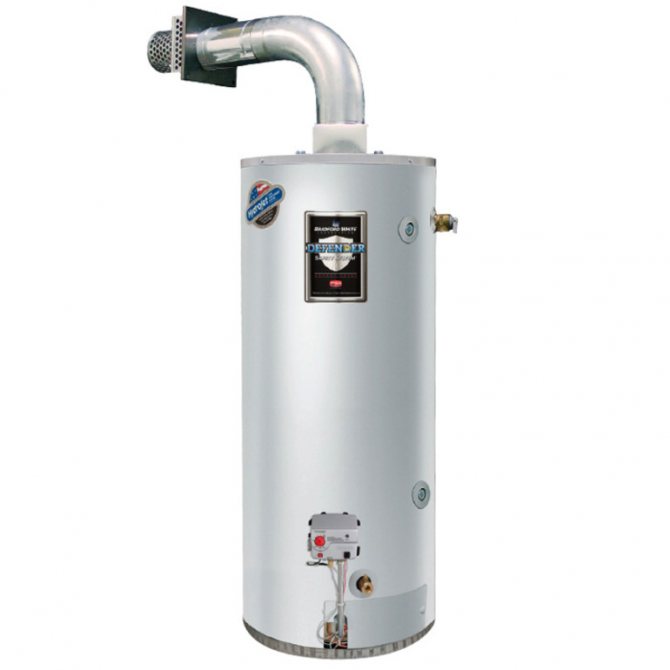

- Ariston S / SGA 50 R - gas boiler from Italian manufacturers with an open combustion chamber. The volume of the container is 50 liters, the nominal temperature of water heating is 75 ° C. The boiler does not need to be connected to the mains, which makes it more economical. If necessary, it is possible to switch to liquefied gas.
- Hajdu GB 80.2−02 - the boiler is designed to heat 80 liters of water for household and domestic needs. A chimney is not required to use the equipment. The heated water can be used for food purposes. The burner is equipped with a piezoelectric ignition and a pilot torch. The operation of the equipment is protected by a thermoelectric interlock.
- Baxi SAG-3 150 - floor-standing boiler running on liquefied gas. The heater has a built-in draft sensor that monitors the output of combustion products. The tank is equipped with a magnesium anode against corrosion and thermal insulation made of polyurethane foam. The volume of the container is 150 liters.
In addition to these models, Electrolux, Termex, Gorenje, etc. are popular.
